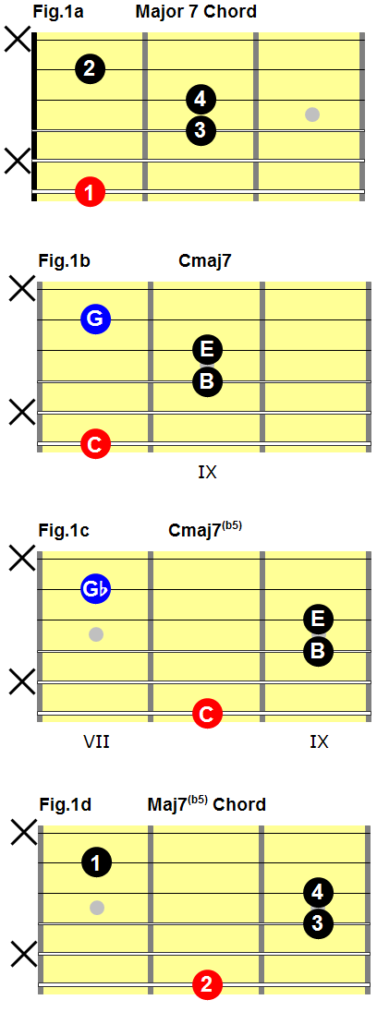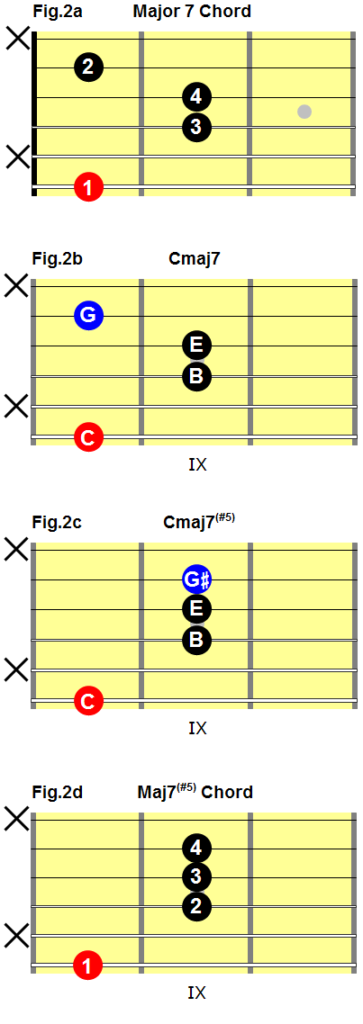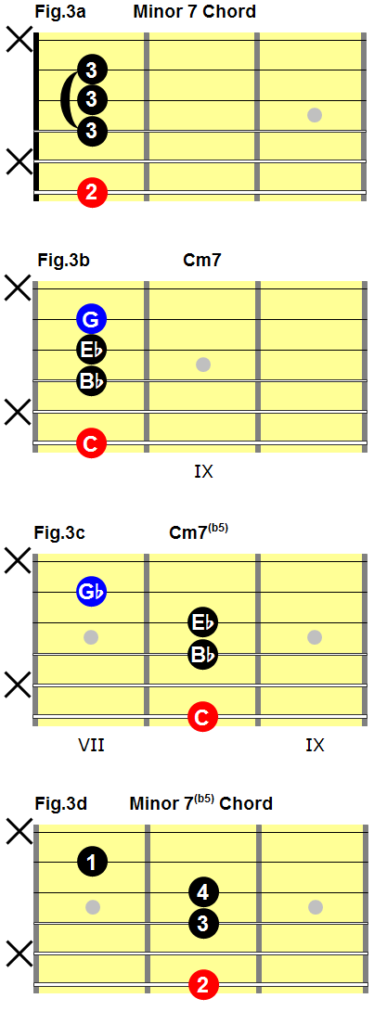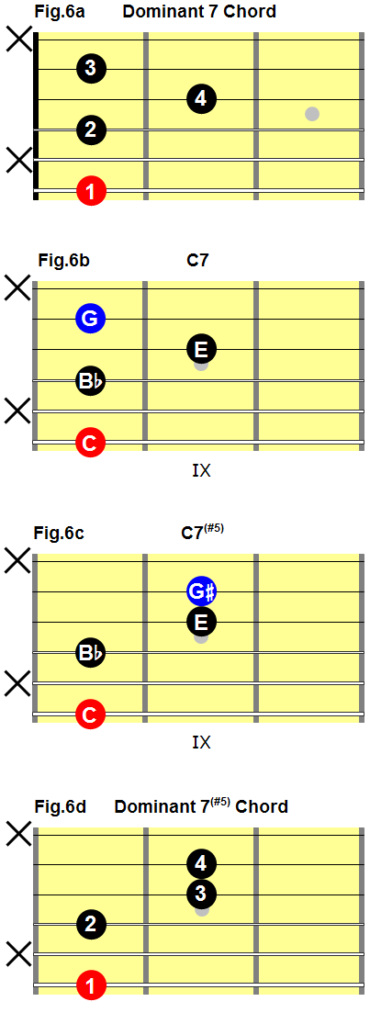My last post took us through the process of altering basic seventh chord voicings on a guitar to create voicings for sixth, ninth and altered chords.
This post will provide instruction on how to alter seventh chord voicings to create voicings for chords with altered fifth scale degrees.
Altered Fifth Chord Voicings
Rule: To create an altered fifth chord voicing, alter the fifth note in a seventh chord voicing.
Altered Major Chords
Creating Major Seventh, Flat Five Chords: Theory
The chord formula for a major seventh chord is 1, 3, 5, 7.
The chord formula for a major seventh, flat five chord is 1, 3, b5, 7.
The only difference between the two chords is that a major seventh chord contains the fifth scale degree, and a major seventh, flat five chord contains the flatted fifth scale degree instead.
To create a major seventh, flat five chord voicing from a major seventh chord voicing:
- Locate the note in the major seventh chord that is the scale’s fifth degree.
- Change that note to the note that is the scale’s flatted fifth degree.
Creating Major Seventh, Flat Five Chords: On a Guitar
To create a Cmaj7(b5) chord voicing from a Cmaj7 chord voicing:
- Locate the note in the Cmaj7 chord that is the scale’s fifth degree (G).
- Change that note to the note that is the scale’s flatted fifth degree (Gb).
A common fingering for a major seventh chord is shown in fig.1a.
To play a Cmaj7 chord, place your first finger on the C on the sixth string, eighth fret (fig.1b).
To create a Cmaj7(b5) chord:
- Locate the G in the Cmaj7 chord (highlighted in blue).
- Change the G to a Gb (fig.1c, highlighted in blue).
You now have a movable major seventh, flat five chord fingering (fig.1d).
Fig.1

Creating Major Seventh, Sharp Five Chords: Theory
The chord formula for a major seventh chord is 1, 3, 5, 7.
The chord formula for a major seventh, sharp fifth chord is 1, 3, #5, 7.
The only difference between the two chords is that a major seventh chord contains the fifth scale degree, and a major seventh, sharp five chord contains the sharped fifth scale degree instead.
To create a major seventh, sharp five chord voicing from a major seventh chord voicing:
- Locate the note in the major seventh chord that is the scale’s fifth degree.
- Change that note to the note that is the scale’s sharped fifth degree.
Creating Major Seventh, Sharp Five Chords: On a Guitar
To create a Cmaj7(#5) chord voicing from a Cmaj7 chord voicing:
- Locate the note in the Cmaj7 chord that is the scale’s fifth degree (G).
- Change that note to the note that is the scale’s sharped fifth degree (G#).
A common fingering for a major seventh chord is shown in fig.2a.
To play a Cmaj7 chord, place your first finger on the C on the sixth string, eighth fret (fig.2b).
To create a Cmaj7(#5) chord:
- Locate the G in the Cmaj7 chord (highlighted in blue).
- Change the G to a G# (fig.2c, highlighted in blue).
You now have a movable major seventh, sharp five chord fingering (fig.2d).
Fig.2

Altered Minor Chords
Creating Minor Seventh, Flat Five Chords: Theory
The chord formula for a minor seventh chord is 1,b3, 5, b7.
The chord formula for a minor seventh, flat five chord is 1, b3, b5, b7.
The only difference between the two chords is that a minor seventh chord contains the fifth scale degree, and a minor seventh, flat five chord contains the flatted fifth scale degree instead.
To create a minor seventh, flat five chord voicing from a minor seventh chord voicing:
- Locate the note in the minor seventh chord that is the scale’s fifth degree.
- Change that note to the note that is the scale’s flatted fifth degree.
Creating Minor Seventh, Flat Five Chords: On a Guitar
To create a Cm7(b5) chord voicing from a Cm7 chord voicing:
- Locate the note in the Cm7 chord that is the scale’s fifth degree (G).
- Change that note to the note that is the scale’s flatted fifth degree (Gb).
A common fingering for a minor seventh chord is shown in fig.3a.
To play a Cm7 chord, place your second finger on the C on the sixth string, eighth fret (fig.3b).
To create a Cm7(b5) chord:
- Locate the G in the Cm7 chord (highlighted in blue).
- Change the G to a Gb (fig.3c, highlighted in blue).
You now have a movable minor seventh, flat five chord fingering (fig.3d).
Fig.3

Creating Minor Seventh, Sharp Five Chords: Theory
The chord formula for a minor seventh chord is 1,b3, 5, b7.
The chord formula for a minor seventh, sharp five chord is 1, b3, #5, b7.
The only difference between the two chords is that a minor seventh chord contains the fifth scale degree, and a minor seventh, sharp five chord contains the sharped fifth scale degree instead.
To create a minor seventh, sharp five chord voicing from a minor seventh chord voicing:
- Locate the note in the minor seventh chord that is the scale’s fifth degree.
- Change that note to the note that is the scale’s sharped fifth degree.
Creating Minor Seventh, Sharp Five Chords: On a Guitar
To create a Cm7(#5) chord voicing from a Cm7 chord voicing:
- Locate the note in the Cm7 chord that is the scale’s fifth degree (G).
- Change that note to the note that is the scale’s sharped fifth degree (G#).
A common fingering for a minor seventh chord is shown in fig.4a.
To play a Cmaj7 chord, place your second finger on the C on the sixth string, eighth fret (fig.4b).
To create a Cm7(#5) chord:
- Locate the G in the Cm7 chord (highlighted in blue).
- Change the G to a G# (fig.4c, highlighted in blue).
You now have a movable minor seventh, sharp five chord fingering (fig.4d).
Fig.4

Altered Dominant Chords
Creating Dominant Seventh, Flat Five Chords: Theory
The chord formula for a dominant seventh chord is 1, 3, 5, b7.
The chord formula for a dominant seventh, flat five chord is 1, 3, b5, b7.
The only difference between the two chords is that a dominant seventh chord contains the fifth scale degree, and a dominant seventh, flat five chord contains the flatted fifth scale degree instead.
To create a dominant seventh, flat five chord voicing from a dominant seventh chord voicing:
- Locate the note in the dominant seventh chord that is the scale’s fifth degree.
- Change that note to the note that is the scale’s flatted fifth degree.
Creating Dominant Seventh, Flat Five Chords: On a Guitar
To create a C7(b5) chord voicing from a C7 chord voicing:
- Locate the note in the C7 chord that is the scale’s fifth degree (G).
- Change that note to the note that is the scale’s flatted fifth degree (Gb).
A common fingering for a dominant seventh chord is shown in fig.5a.
To play a C7 chord, place your first finger on the C on the sixth string, eighth fret (fig.5b).
To create a C7(b5) chord:
- Locate the G in the C7 chord (highlighted in blue).
- Change the G to a Gb (fig.5c, highlighted in blue).
You now have a movable dominant seventh, flat five chord fingering (fig.5d).
Fig.5

Creating Dominant Seventh, Sharp Five Chords: Theory
The chord formula for a dominant seventh chord is 1, 3, 5, b7.
The chord formula for a dominant seventh, sharp five chord is 1, 3, #5, b7.
The only difference between the two chords is that a dominant seventh chord contains the fifth scale degree, and a dominant seventh, sharp five chord contains the sharped fifth scale degree instead.
To create a dominant seventh, sharp five chord voicing from a dominant seventh chord voicing:
- Locate the note in the dominant seventh chord that is the scale’s fifth degree.
- Change that note to the note that is the scale’s sharped fifth degree.
Creating Dominant Seventh, Sharp Five Chords: On a Guitar
To create a C7(#5) chord voicing from a C7 chord voicing:
- Locate the note in the C7 chord that is the scale’s fifth degree (G).
- Change that note to the note that is the scale’s sharped fifth degree (G#).
A common fingering for a dominant seventh chord is shown in fig.6a.
To play a C7 chord, place your first finger on the C on the sixth string, eighth fret (fig.6b).
To create a C7(#5) chord:
- Locate the G in the C7 chord (highlighted in blue).
- Change the G to a G# (fig.6c, highlighted in blue).
You now have a movable dominant seventh, sharp five chord fingering (fig.6d).
Fig.6

Related Posts
Related posts include:
